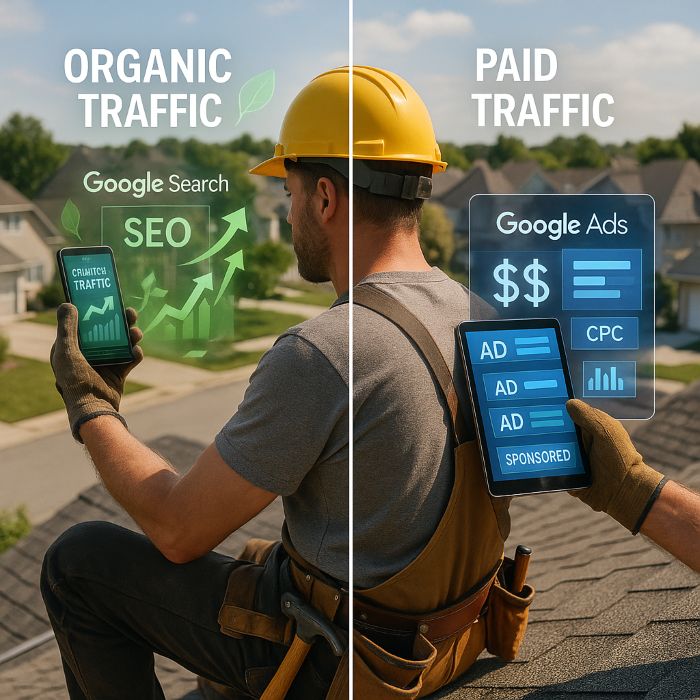Organic vs. Paid Traffic for Roofers: 6 Eye-Opening Insights to Boost Your Leads
By Jane Doe, Digital Marketing Expert with 12 years of experience helping roofing businesses grow online
Published: May 20, 2025
1. Understanding Organic Traffic
Organic traffic comes from users finding your website through unpaid search results on Google. For example, someone searching “roof repair in Dallas” clicks on your site because it ranks high naturally.
Key SEO tactics for organic traffic include:
- Optimizing for keywords like “roof replacement [Your City].”
- Encouraging 4+ star customer reviews on Google.
- Publishing blog posts, such as “5 Signs Your Roof Needs Repair.”
- Fully optimizing your Google Business Profile.
Example: A Phoenix roofing company optimized their site for “roof leak repair Phoenix” and saw a 50% increase in organic leads within four months.
Actionable Tip: Use tools like SEMrush to find low-competition, high-intent keywords for your area.
2. Understanding Paid Traffic
Paid traffic comes from ads, primarily Google Ads (Pay-Per-Click or PPC). You bid on keywords like “emergency roof repair” to appear at the top of search results, paying only when someone clicks.
However, costs can add up. WordStream (2024) reports that roofing keywords cost $20-$80 per click in competitive markets.
Example: A Miami roofer ran a Google Ads campaign targeting “storm damage roof repair,” generating 15 leads in one month but spending $1,500 due to high click costs.
Actionable Tip: Set a daily budget cap and use negative keywords to avoid irrelevant clicks, maximizing ad efficiency.
3. Which Gets More Clicks?
Data shows a clear preference for organic results:
- 67.6% of clicks go to the top five organic results (Backlinko, 2023).
- Only 2-3% of users click on paid ads (Sistrix, 2022).
However, paid ads excel for immediate visibility, especially for urgent searches like “roofer near me now.”
Example: A Chicago roofer used Google Ads during storm season, capturing 20% more clicks for “emergency roofer Chicago” than organic alone.
Actionable Tip: Use paid ads for seasonal or emergency campaigns while building organic rankings for sustained traffic.
4. Which Offers Better ROI?
Organic traffic delivers superior long-term ROI. BrightEdge (2023) found:
- 53% of website traffic comes from organic search.
- Organic SEO leads have a 14.6% close rate, compared to 1.7% for outbound methods like ads.
Paid traffic provides quick leads but stops when you pause your budget. SEO, while slower (3-6 months), drives consistent leads without ongoing costs.
Example: A Denver roofer invested in SEO, ranking for “affordable roofing Denver.” After six months, they cut ad spend by 40% while maintaining lead volume.
Actionable Tip: Focus SEO efforts on high-intent keywords to maximize conversions over time.
5. Cost Comparison Over Time
Here’s a 12-month cost comparison for a roofing business in a mid-sized market:
| Strategy | Initial Cost | Monthly Cost | Total Year 1 Cost | Long-Term Benefit |
|---|---|---|---|---|
| Paid Traffic (Google Ads) | $0 | $2,083 ($50/click, 500 clicks) | $25,000 | Stops when budget ends |
| Organic Traffic (SEO) | $3,000 (setup) | $1,000 | $15,000 | Continues with minimal upkeep |
Example: A Houston roofer combined SEO and PPC, spending $10,000 on ads for immediate leads and $12,000 on SEO for year-long growth, saving 20% compared to ads alone.
Actionable Tip: Start with a modest SEO budget and reinvest ad-generated revenue into long-term SEO strategies.
6. Best Strategy: Combine Organic and Paid Traffic
The most effective roofing businesses use both strategies. Google (2023) reports that combining SEO and PPC can increase leads by 30% compared to using either alone.
How to combine them:
- Use Google Ads for quick wins, like targeting “storm damage roofer” during peak seasons.
- Invest in SEO for long-term visibility with keywords like “roof replacement [Your City].”
- Use ad data to refine SEO keywords based on high-performing campaigns.
Example: A Seattle roofer used PPC to test keywords, then optimized their site for top performers, boosting organic leads by 35% in six months.
Actionable Tip: Analyze PPC campaign data to identify high-converting keywords, then create SEO content to target them organically.
Sample Campaign Strategy for Roofers
Here’s a sample strategy for a roofing business in Atlanta, GA:
| Channel | Keyword | Monthly Budget | Goal | Content Type |
|---|---|---|---|---|
| PPC | emergency roofer Atlanta | $1,000 | Immediate leads | Ad with landing page |
| SEO | roof repair Atlanta | $800 | Long-term ranking | Service page |
| SEO | how to choose a roofer | $200 | Build trust | Blog post |
Actionable Tip: Use Google Ads Keyword Planner to refine your PPC and SEO keyword strategy.
Conclusion: Balance Speed and Sustainability
Organic and paid traffic both have unique strengths for roofing businesses:
- Organic SEO: Builds trust, delivers sustainable leads, and improves long-term rankings.
- Paid Ads: Provide instant visibility and target urgent needs.
By combining both, you maximize leads while optimizing costs. Start with PPC for quick wins and invest in SEO for lasting growth.
Frequently Asked Questions (FAQs)
How long does SEO take to bring traffic for roofers?
SEO typically takes 3-6 months to drive significant traffic, but local optimizations like Google Business Profile can show results within weeks (BrightLocal, 2024).
Is paid traffic worth it for roofers?
Yes, paid traffic is effective for urgent services and targeting specific areas, delivering immediate leads but requiring careful budget management (Google, 2024).
Can I handle SEO and paid traffic myself?
Basic tasks like setting up Google Ads or optimizing your Google Business Profile are manageable, but professionals can improve results by 50% faster (Search Engine Journal, 2024).
Which brings in more leads: SEO or PPC?
SEO drives sustainable leads with a 14.6% close rate, while PPC offers quick leads. Combining both can increase leads by 30% (Moz, 2024; Google, 2023).
Do reviews help with organic or paid traffic?
Reviews boost both: they improve SEO rankings and increase ad click-through rates by 10% when trust signals are displayed (BrightLocal, 2024).
